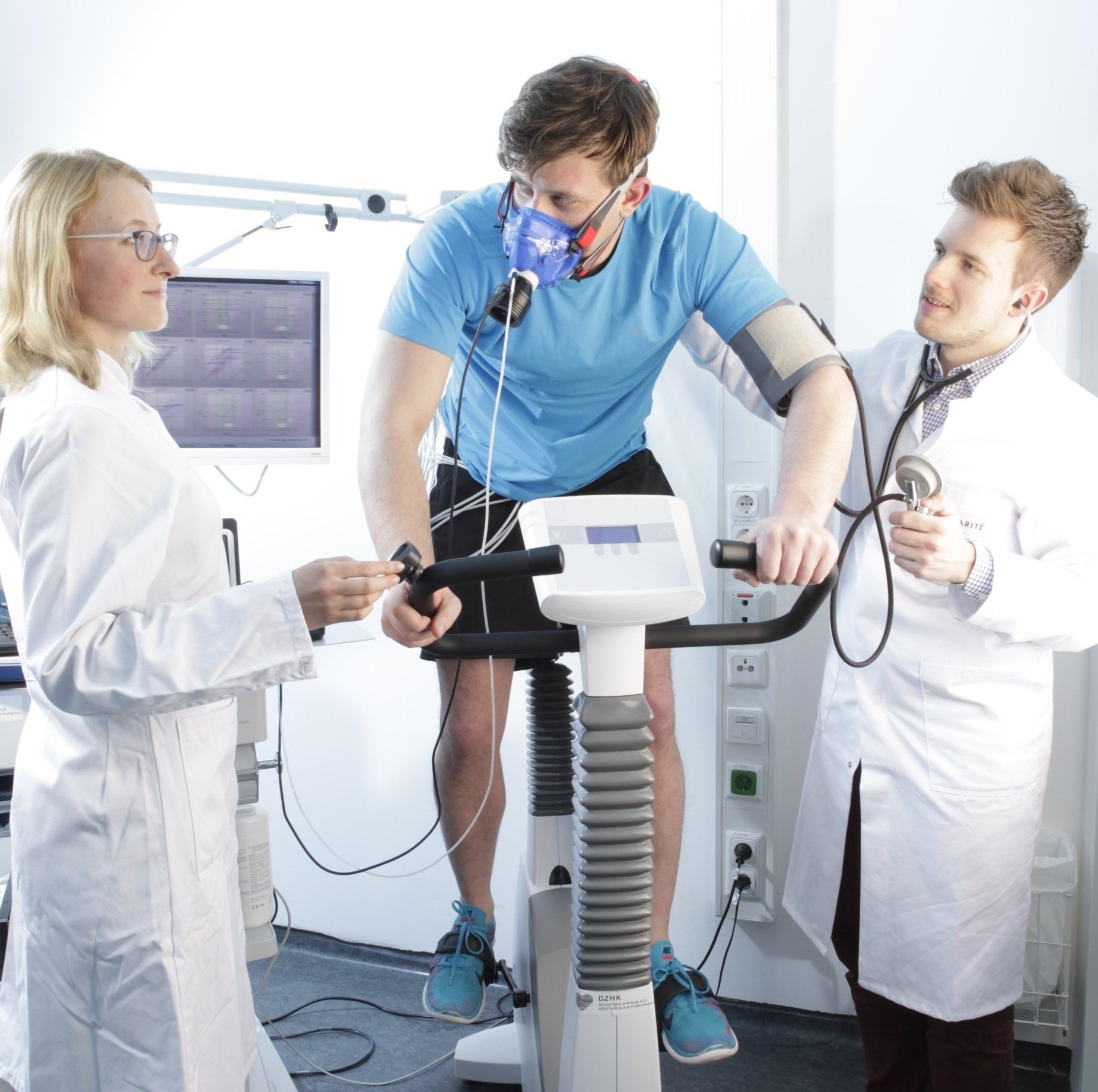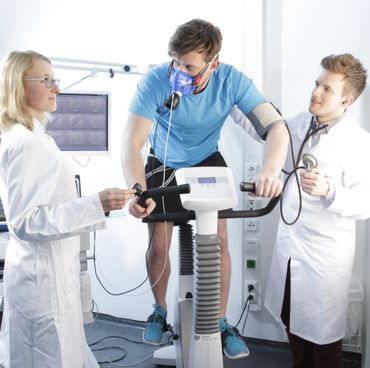678-636-3060
Sales@mettest.net
-

SURVIVAL OF THE FITTEST
Cardiorespiratory Fitness, also known as Functional Capacity or Exercise Capacity is the #1 predictor of longevity and all-cause mortality.
How does MET-Test Work? -

Annual Fire-Fighter Cardiovascular Health Assessment
Sudden cardiac death accounts for approximately half of all on-duty death among firefighters and occurs at higher rates than those found in similar occupations.
For more Information -

CORPORATE WELLNESS
Benefits of an effective corporate wellness program are touted to promote a healthy workforce for the overall benefit of the employee, reduce time missed at work due to chronic health issues, and reduce the cost of group insurance packages by reducing the usage of insurance benefits for chronic disease management.
For more Information -

HEART DISEASE PREVENTION
The goal is to increase peak VO2 from baseline by 10% or more per test until the underlying cardiac dysfunction pattern is completely normalized.
HOW TO GET STARTED -

MYADESSO: A NEW WAY TO WELL
Write your caption hereFor More information
INDUSTRY LEADER IN CARDIOPULMONARY DIAGNOSTIC SERVICES
We offer individual-specific management feedback with data-driven state of the art technology using
powerful proprietary pattern recognition software derived from testing over 200,000 patients in the healthcare system. Implementing our 20 years of real-world expertise working with doctors enables at-risk organizations to
reduce healthcare costs by optimizing the cardiovascular health of their population.
15.5 Million
People diagnosed in the U.S. 1
370,000
Deaths in the U.S. per year 2
$182 Billion
U.S. cost per year 1
1. American Heart Association, 2015 Heart Disease and Stroke Statistics Update.
2. Centers for Disease Control and Prevention, Heart Disease Facts.
European Heart Journal (2022) & Current Opinion in Cardiology (2023)
CLINICAL RESEARCH

Only a select group of CAD patients undergoing coronary stent procedures actually experience an improvement in angina and quality of life. Out of the non-invasive and invasive tools available, CPET is currently the most effective at determining which patients are likely to benefit from coronary stent placements and which patients are likely to see no significant changes post-op.

September 08, 2023 - Cardiopulmonary exercise testing (CPET) is the gold standard for directly assessing cardiorespiratory fitness (CRF) and has a relatively new and evolving role in evaluating atherosclerotic heart disease, particularly in detecting cardiac dysfunction caused by ischemic heart disease. The purpose of this review is to assess the current literature on the link between cardiovascular (CV) risk factors, cardiac dysfunction and CRF assessed by CPET.
HOW MET-TEST WORKS?
List of Services
-
STEP #1Item Link List Item 1
Feeling tired, out of breath, experiencing chest pain, light-headedness, or loss of energy and performance?
Are you concerned about your heart health and want to make sure you are doing everything possible to live a better and longer life?
-
STEP #2What is CPET? List Item 2
Your doctor can order the cardiopulmonary exercise test (CPET) which is non-invasive, uses no radiation and will detect any significant underlying heart or lung issue.
-
STEP #3Item Link List Item 3
The completed test is electronically sent to MET-TEST’s secured centralized data center using state-of-the-art analytical tools, trained specialists, and powerful proprietary pattern recognition software. MET-TEST generates a detailed report of your heart and lung health that your doctor will use to create a custom treatment plan for you.
-
STEP #4Item Link List Item 4
These results give you and your doctor the answers needed to determine the next step in your treatment plan. Most plans consist of lifestyle changes, exercise prescriptions and optimizing medical management. Referral to a specialist can be made if indicated. Your doctor will track your response to therapy using serial testing comparisons to ensure that you are headed in the right direction.
-
RESULTS - Increasing Fitness by 5 ml/kg/min will* Mayo Clinic Proceedings Volume 93, Issue 1, January 2018, Pages 48-55
Cardiovascular Deaths
Decrease by 23%
Cancer
Decrease by 20%
Annual Healthcare*
Decrease Costs by ~$2,000 (Per Individual)
WHAT IS CARDIOPULMONARY EXERCISE TEST (CPET)?
Cardiopulmonary Exercise Test (CPET) is the only non-invasive exercise stress test that assesses heart and lung function in real-time during exercise. Your heart and lungs work together to deliver oxygen to your working muscles where it is used to make energy; and to remove carbon dioxide from the body. CPET measures the amount of oxygen your body is using, the amount of carbon dioxide it is producing, your breathing pattern, and electrocardiogram (EKG) while you are riding a stationary bicycle.
This data undergoes expert analysis in the data center where exercise capacity is quantified using MET-TEST powerful proprietary pattern recognition software, and the mechanism of patient symptoms is prioritized.
Click here for more information on Cardiopulmonary Exercise Test (CPET)
WHAT IS PEAK VO2 AND WHY IS IT SO IMPORTANT?
Cardiorespiratory Fitness, also known as Functional Capacity or Exercise Capacity is the #1 predictor of longevity and all-cause mortality . Fitness is quantified as the volume of oxygen metabolized at peak exercise in ml/kg/min and is expressed as VO2-Max (Maximal Muscle Aerobic Capacity) or Peak VO2 (Highest level of O2 consumption attained at peak exercise). Low levels of fitness (Peak VO2) have been linked to decreased survival from heart disease, stroke, lung disease, cancer, kidney disease as well as increased incidence of hypertension, diabetes, high cholesterol, dementia, pneumonia and osteoporosis (weak bones). Peak VO2 is an accurate reflection of chronic diseases on the aging process and reflects the physiological “reserve” remaining in an individual. Based on age, height, weight and sex, each person has Peak VO2 values that correspond to 100% of predicted. Individuals with Peak VO2 > 100% predicted live the longest with fewest health problems whereas those with Peak VO2 < 60% of predicted have the shortest survival with the most health problems in a dose-dependent manner. Healthcare costs have also been shown to increase incrementally with decreasing peak VO2.
“Individuals whose Peak VO2 increases between examinations have a lower risk of adverse health and clinical outcomes than those whose Peak VO2 decreases, and this should be communicated to patients”. 1
Thus, the goal in every person is to increase Peak VO2 from baseline to provide objective evidence that long-term survival and healthcare costs are headed in the right direction. Increasing functional capacity (Peak VO2 ) requires an intricate understanding of the mechanism of exercise limitation (the cause of symptoms in patients with shortness of breath, chest pain and fatigue). Therapeutic interventions must target the primary mechanism of exercise limitation in order to increase Peak VO2. MET-TEST has 20 years of real-world expertise in assisting primary doctors and cardiologists to more precisely identify the cause of exercise limitation and target therapy accordingly.
1. Ross et al. Importance of Assessing Cardiorespiratory Fitness in Clinical Practice: A Case for Fitness as a Clinical Vital Sign: A
Scientific Statement From the American Heart Association. Circulation. 2016;134:00–00.
FIREFIGHTERS AND FIRST RESPONDERS
Sudden cardiac death accounts for approximately half of all on-duty death among firefighters
Firefighting work demands can be extreme and an accurate assessment of cardiopulmonary status, as well as detection and treatment of any underlying cardiovascular disease, is critical to ensured firefighter fitness for duty and prevent on-duty cardiac events or death. Exercise stress testing serves two primary purposes in assessing firefighter safety; evaluation of cardiorespiratory fitness and detection of under-treated cardiovascular disease. Cardiopumonary Exercise Testing (CPET) has made significant advances in the last decade and is superior to the traditional Treadmill stress test (Treadmill vs. CPET). To accomplish these goals upgrade to MET-TEST.
Click here for more Information on Firefighter
Firefighter Safety Thru Advanced Research (FSTR) Recommends CPET over Traditional Stress Testing.
Featured Study - Published: 2010 by The Journal of Strength and Conditioning Research

In order to provide first responders with more concrete information about their health, MET-TEST developed a three-step program that offers measurable, actionable health data.
WOMEN'S HEALTH AND CPET
Over the last decade, our understanding of women’s heart disease has improved exponentially, and it has become apparent that heart disease affects men and women in different ways. Here are some facts about heart disease in women: (1,2,3)
- Heart disease is the number #1 cause of death in women
- 1 in 3 women will die of a heart attack or stroke
- Heart disease causes more deaths in women than all forms of cancer combined
- Two-thirds of women with heart disease report no symptoms prior to a heart attack
- Almost half of African-American women over the age of 20 have heart disease
- 90% of all women have 1 or more risk factors for heart disease and stroke
Click here
for more Information on Women's Health
MET-TEST HEALTHCARE TECHNOLOGY | IN THE NEWS
List of Services
-
PHOENIX (FOX 10) -- It was a misdiagnosis that nearly cost a Valley firefighter his life.Play List Item 1
Glendale firefighter Dennis Dorrance was struggling to breathe, but he said a routine physical exam at work is what saved him. Dorrance was treated at Biltmore Cardiology, diagnosed with a condition he didn't even know he had.
Published May 20, 2019 | Health | FOX 10 Phoenix
-
TAMPA FLORIDA (ABC News) -- Linda HurtadoPlay List Item 2
A Local Interventional cardiologist hightlights the value MET-TEST brings to his practice to improve cardiac care for his Patients.
-
ARIZONA'S FAMILY (CBS Evening News)Play List Item 3
First responders are more likely to have serious health problems than the general public. Jason Barry took us a to a Mesa medical practice that hopes to change that.
Published January 26,2018 | AZ Family
-
PHOENIX (NBC News) -- Firefighters 300x more likely to develop heart problemsPlay List Item 4
In an effort to raise awareness about cardiac disease in first responders, Phoenix-area firefighters are participating in National Safety Stand Down Awareness Week. Scottsdale Fire Department partners with Heartfit for Duty, a local company that uses a variety of tests and algorithms to monitor the health of firefighters.
Published June 6, 2019 | 12NEWS | Lisa Nico
© 2022 MET-TEST, LLC. | All Rights Reserved



